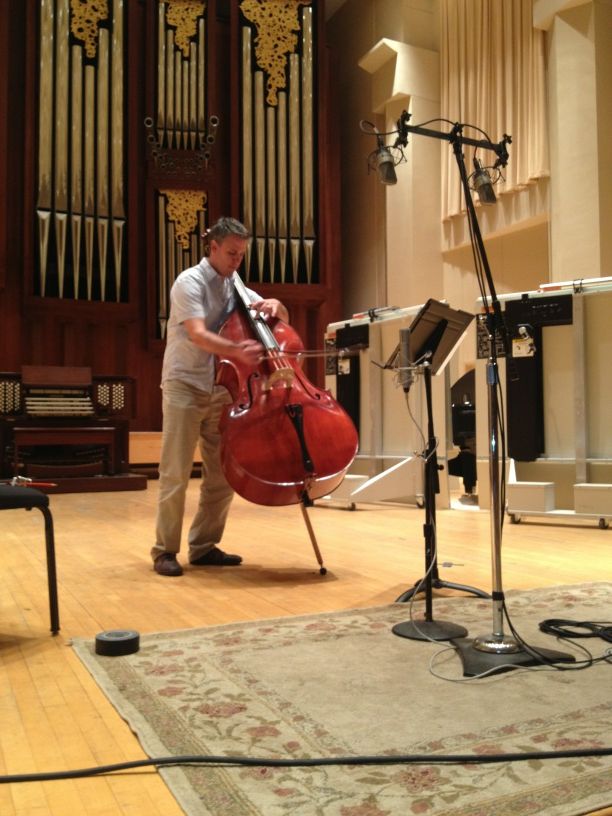There are probably as many ways to mic a double bass as there are double bassists. It’s a topic I’ll definitely be coming back to a few times I’m sure. But meanwhile, I want to talk about three fairly standard ways of doing it.
If you’re getting ready to record, it might be worthwhile to try these out and see what works best for your playing, in the room you’ll record, with your bass.
Stereo pair, up and out front about 8 feet
I’ve seen this setup recommended by many audition-related sites. Here’s a visual from Sandor Ostlund’s Twitter stream:

Here is a pair of stereo mics out in front of a bass and elevated up, about six feet in both cases. The mics are probably large diaphragm condensers (Neumann U67 or similar) positioned about two feet apart from another.
In this configuration you can get a bit of stereo imaging to help capture the sound of the room, which can give the recording a good feel if the room sounds good. Also, the mic pointed more towards the lower strings will sound bassier and the one pointed more towards the higher strings will sound treblier so you might be able to blend for a good tone.
One thing to be careful with in this configuration is phasing issues. Phasing will get it’s own treatment here eventually because it’s a significant problem with bass instruments. But the short version is: sound waves that get slightly misaligned can cancel each other out. One way that sound waves get misaligned is when they are captured from two different microphones that are placed a distance apart, like in this configuration.
You’ll know you have a phase problem if the tone of your recording is hollow or just plain “off.” You can fix a phasing issue either by moving the mics a little bit or by doing tweaks in the recorded files (basically realigning the phase). Doing tweaks is a pain though, so best to try work with mic spacing first and spare your engineer the headache if you can.
In the photo above, there is a third microphone, lower down, that is probably being used to help deal with any potential phasing issues. You can use just the single mic if the phase is too bad from the stereo pair, then blend in a small amount of the stereo pair to bring in just enough room sound to give life but not enough out-of-phase sound to suck the tone out of the recording.
You can see another example of the stereo pair in this video by Lisa Dowling.
M/S Array mic for bass
In the lower right of the video cover image, you can see the M/S microphone array used to record Lauren Pierce performing Zigeunerwiesen on double bass. M/S stands for middle/side or mid/side. It uses two microphones, like the stereo pair, but avoids the phasing issues by using some fancy math.
One microphone collects sound straight in front of it and the other microphone, placed as closely to the first as possible, collects sound in a “figure 8 pattern” — from the sides and not the front and back.
These two microphones–one collecting the middle and other collecting the sides– are then combined using specialized (but readily available in free and paid variants) software. Once recombined, you get the stereo sound of the room without the phasing issues of a stereo pair.
This is a fancy, but great way to record if you have a mic that can do a figure 8 pattern. Most ribbon mics, for example, are naturally figure 8.
Single mic, at a distance
The simplest and and least troublesome mic technique for double bass recording is to use just one microphone–no phasing issues! You won’t get the stereo image of the room you’re in but that might be an acceptable tradeoff.
Placing the mic at a distance will help put some of the sound of the room into the recording. In this video you can see and hear Gennady Krutikov using a single mic at a distance as he performs Vocalise.
Some parting thoughts
Microphone technique is one of those subtleties of recording. It is usually the first place in which the performing bassist hands off their tone and musicality to another person, the recording engineer.
The ability to perform the piece well and the tone of the instrument itself will have a greater impact on the sound of the recording. But mic technique will be among things the recording engineer can use to greatest advantage (and hopefully not disadvantage!) in reproducing the sound of the bass.
There are many more aspects to this topic, in particular how close and far, how high and low, which side to favor when placing a single mic (or focusing an M/S or Stereo Array). And there are other techniques as well.
But these three should give us all a good start to make good recordings of the pieces we are making.

Pingback: Three years worth of business/music ideas, mic technique for double bass, music from Edicson Ruiz - PATTERNROOT